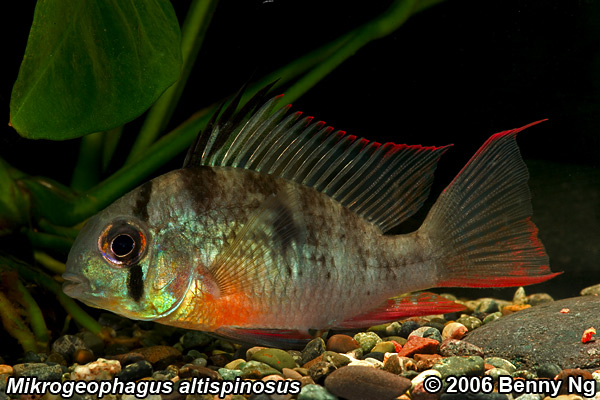Joopsg, you might want to quote the name of the website you got the pictures from...
Benny has an image of the fish in our gallery yuo can use too...

Trade Name: Bolivian Ram
Other Name: Butterfly Ram, Red Ram
Scientific Name: Mikrogeophagus altispinosa
Distribution: South America,Bolivia, Brazil
Size:Males up to 4 inches with females slightly smaller
Diet: These fish are omnivores and readily accept most dry and live foods
Temperature: 25- 28 Degrees
Water Chemistry: dH 1-10, Softwater is favoured
pH: pH 6.0-7.0 is favoured, although they can be acclimated upto pH 7.8
Life Span: Approx 2-4 years (Very Hardy)
Housing: The tank should have a length of 2FT with a lot of plants and other hiding places
Sexual Dimorphism: The male is slimmer than the female and has more coloration along with extensions on its upper and inner caudal fin rays. My other observation to choose a pair. The male breeding tube is pointed while the female is round. I use this method to successfully obtaining 2 pairs.
Breeding: These fish are biparental, open substrate spawners. To provide a pebble to spawn or they will spawn on any flat surface. Seen before on substrate and driftwood. After a pair forms, the male will begin courting the female. Usually courting consists of mouthing certain objects in the courtship area. After a few days, the pair will clean around a rock or some object in the substrate. At this point, the male may become more aggressive than usual, chasing tank mates around, without damaging them, just warning. During the beginning of the spawning ritual, the female will lay a few eggs and move out of the way, while the male quickly follows up and fertilizes them. They will continue doing this until there are 100-200 fertilized eggs. After the spawning, the male will usually guard the territory while the female fans the eggs with her pectoral fins. This happens for most of the time, except when the male will occasionally relieve the female. While passing each other, they give a reciprocal lateral display signaling the 'shift change'. The female will usually come back within 30 seconds and reclaim her duty, although no display is shown during her re-entry. After the eggs hatch and the fry are wigglers, the pair tends to change color, showing yellowish bodies, intense eye stripes and lateral blotches. It is known that Rams make poor parents and while it is not unusual for them to be decent parents, you should still remove the fry if you plan to raise them.
Picture from the net From Lee Newman:
Male Female Breeding Pair
Last edited by joopsg; 10th Oct 2007 at 21:47. Reason: Spelling 'Microgeophagus' to 'Mikrogeophagus'

Joopsg, you might want to quote the name of the website you got the pictures from...
Benny has an image of the fish in our gallery yuo can use too...

Read me! :bigsmile: http://justikanz.blogspot.com/
I'm crypt collecting... Starting cheap, now have Cryptocoryne beckettii, C.beckettii var petchii, C.crispatula var.balansae, C.griffithii(Melted!), C.nurii, C.parva, C.pygmaea(Melted!
), C.tonkinensis(Melted!
), C.walkeri, C.wendtii 'Brown', C.wendtii 'Green', C.wendtii 'Green Gecko', C.wendtii 'Tropica' and Cryptocoryne x willisii
Oh, juggling is hard work, man!...

Wow. I have this fish too and so beautiful fish.
Bookmarks